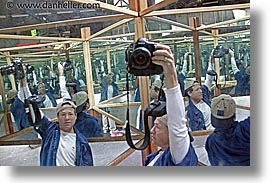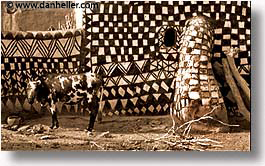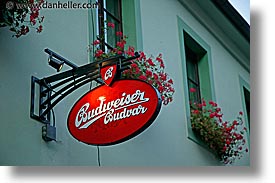|
Markers indicate locations for photos on this page.
Accuracy responsibility of Google Maps
Google Map Goes Here
If you see this text, the map is still loading (or there's an error). |
The main objective of this chapter is not to help you figure out which
marketing method is right for you, nor how to implement it once you figure
it out. Sure, you have to know how to make a portfolio, but that's a task,
and you can find plenty of books that discuss this. It's folding that
"task" into the bigger picture of your business model that will help you
market yourself effectively, and that's what this chapter is about.
Your objective is to understand which marketing strategies are most
appropriate for photographers, and which may be right for you. Once you
have that, you can then intelligently "do" your marketing plan by learning
the individual tasks elsewhere.
Therefore, the kind of marketing that photographers did has always been less directed towards the end buyer, as it was towards those middle-men in the supply chain that controlled the distribution channel. Having a strong portfolio and getting it into the hands of art directors and photo agencies were seen as the only way to build a career in this business.
Today, marketing has broadened its scope, format, audience, and methods. Photographers may still target agencies and other middlemen to represent them, but they also go direct to the buyer. This complicates the marketing plan because those different targets require different approaches. What's more, different clients have different financial returns (e.g., direct to buyer versus agency), so part of the marketing equation has to factor in the return on investment. (That is, should you send expensive portfolios to agencies, when the time and cost of doing so can be redirected towards a more profitable sales strategy?) These questions have had a direct impact on the nature of how marketing is done, who you're competing with, and how any of these efforts contribute to the bottom line.
In this chapter, we'll explore all of this, starting with an analysis
of traditional marketing methods. We present a checklist for weighing
whether (and to what extent) any given approach is effective (and under
what circumstances), and when it's not. We'll then look at how buyers and
agents choose the people they work with, so as to guide how you should
spend your time and resources when developing your own marketing strategy.
What all these have in common is attempting direct contact with specific, pre-qualified targeted buyers. This is called . An overt "push" onto a directly focused group of pre-qualified people who fit a specific profile. You are the one that attempts initial contact. By contrast, there is another approach called, . A broad-based marketing approach, using general mass-media outlets, such as print and television, where potential clients are "pulled in" by a promotion. Here, clients respond by initiating contact with you. Examples of Pull Marketing strategies include:
A simple observation would suggest that the Pull strategy is better because
it reaches more of the target audience. But, the price of producing and
placing an ad in such a magazine may be prohibitive. Moreover, a direct
mailing may not be as quickly overlooked as an ad might be. Also, a mailing
can be somewhat personalized, or include target-specific information that
may not be effective in ad. Back to the other hand, the ad can be placed
strategically next to a particular article that your target audience is
highly likely to see. (Such placement often influences brand identity,
which also increases the subtler influence of brand perception.) This type
of pro-and-con analysis should illustrate that one form of marketing is
not inherently better than another—it's more a matter of choosing
based on circumstances. We'll get into more of this type of analysis
throughout the chapter.
The hitch is, Web pages are everywhere, and where your site "ranks" in the noise can either make your business a smashing success, or a huge waste of time and money. Getting it right isn't easy either; most photographers either under-invest by only having a short resume and portfolio, while others over-invest by paying a designer to create a very sexy and unique site that fails to draw in sales or prospective clients. (Many such sites have won awards, which look great in a high-profile magazine, but don't necessarily translate into actual dollars. At least, not for the photographer; the designer usually gets a lot of business, though.)
Despite the challenges, one fact is clear: not using the Web can
actually be harmful, not just because of the lost opportunity, but
can also give the impression that you're not the professional your
clients expect you to be. Would you still use a lawyer that still used a
typewriter because he didn't understand word processors? Because this
subject is so big, I've dedicated an entire chapter to it: Web-based Photography Business.
Whether Push or Pull, if you're casting too wide of a net, your expenses may not be justified by the returns. What's more, you may find that dealing with a huge number of unqualified responses holds you back from being more productive.
Even in high-profile, mass marketing campaigns that span multiple mediums, most people don't recognize a new name or logo in fewer than three exposures, and statistics show that initial contact isn't made in less than five exposures. These examples apply more to magazine advertising in some places, but it is a useful example. Exposure rates and recognizability can vary depending on many criteria, such as long gaps between each exposure, and the number of media outlets used.
As we'll get into later, you need to represent yourself and your product in the context that is relevant to the target audience. That can mean personalizing marketing materials, customizing a portfolio to match exactly what a specific client needs to see, etc. Longer-term planning not only helps in effective marketing, but you also get other benefits: lower prices for higher quantities, the ability to foresee important events, such as conventions, news releases, holidays, or other things germane to your business. Most marketing consultants advise budgeting for an annual marketing plan that includes a series of cross-promotions that include all these approaches. The most aggressive marketing campaigns usually involve the purchase of media packages that include prepayments of up to three years in advance for ads (so as to get a lower per-placement rate). But, let's face it, that kind of planning is beyond where most photographers are who are reading this book.
For everyone else, there's the dilemma: how do you execute a longer-term
marketing strategy on a limited budget? To answer that question, we need
to master the technique of objective analysis of marketing.
Let's return to that hypothetical scenario of sending out postcards to promote yourself to a target audience, and flesh it out some to provide data we can analyze. Let's say you paid $1/card to produce 2000 postcards, and $.50/card to have them labeled, stamped and shipped. Your total cost is $3000. One might gauge the success of this effort on whether enough buyers buy over $3000 worth of product. If ten people responded, and three of them bought $4000 worth of images, would this be deemed a success? Does the fact that we made $1000 define success? Not calculated into the equation are what the expected response rate should have been. If you do pet portraits and you bought a mailing list from a veterinarian that treats show dogs, wouldn't you have expected a much higher response rate? What's the average price per item that the buyers chose? If you are a flower photographer and were selling $15 boxed postcards of pretty flowers, that kind of response rate would be considered a success. What about the indirect costs of the time and effort required to do the mailing? Were longer-term benefits realized? Put another way, could we have chosen another form of marketing that yielded a higher response rate? One that didn't require as much time or effort to produce? What about longer-term benefits? Direct mailings expire anywhere from three days to a week after the recipients received it. Then what? Could time have been spent doing something that has longer-lasting effects?
These two examples illustrate where Push Marketing efforts have different
digress of benefit. We'll look at more soon.
For Pull Marketing, the analysis is even more complex and imprecise. That is, a magazine ad doesn't reach a specific person; it reaches a hypothetical population base. You can measure the number of responses as a percentage of the expected audience size, but you can't gauge the quality of those respondents without directly contacting them. And then you have to make sales. The checklist is still examined, but each item is evaluated differently. Except for internet positioning, Pull Marketing campaigns tend to be ongoing (you buy ad space in time blocks of multiple issues). So, one of the conditions that influences effectiveness is your degree of name-recognition. For example, if you offer wildlife photo workshops in Africa, you may place an ad in an adventure travel magazine like Outdoor Photographer, where your target client will probably see it. Many similar ads can be found in these magazines, so think to yourself: which of those trips would you sign up for, and how did you make that decision? Chances are, you'll scan the array of ads and cull out those whose names you recognize first. That will be your first deciding factor. Whether you find any or not, you'll then look for photos, ad sizes, trip descriptions, and finally, price.
But, then there's that problem with having a tight budget. And, just to be thorough, this all has to do with response rates, not necessarily sales. That problem remains, regardless of how many potential buyers you bring in. Now let's consider an opposite situation. If you are an unknown wedding photographer, you may find it more effective to advertise in the local newspaper or telephone book, since name-recognition is much lower on couples' priority lists. Some go by referrals from friends and family, but by and large, most couples "fish" to find a photographer that works for them. Here, it's your portfolio and personality that closes the sale. (That, and price.)
As we can see, there are conditions in which any kind of marketing
can work for or against you. To a larger degree, name-recognition
plays a big role. But before we get to that, we need to consider
two more items: the randomness factor (i.e., luck) and decision-making
analysis. That is, why do people choose what they choose? (Hint: it
often has nothing to do with the product itself.) So, let's approach
these items in order.
As discussed in Photography and Business Sense, luck does play an unfortunate role in the photography business. But it's not just luck; it's a matter of degree. We know that over the course of time, "success trumps luck." But, in the early days, luck can play a great role in positioning someone to be "successful." As the saying goes:
Successful people tend to be so because they do things that minimize the luck factor. That's what we need to understand here. When you're getting started, competing head-to-head against others in a overly populated market, there's a higher degree of randomness involved. And, when you're talking about something as subjective and interpretive as photography, that randomness factor is multiplied. How do we test this?
Everyone was so impressed that the room glowed, pens and pencils jotting down notes. But, the analytical side of me couldn't help but wonder about the subliminal cognitive triggers in the decision-maker's mind. Was he really responding to the images, or were there other factors involved he might not have been aware of? I know that if I were sent this portfolio, I would not have hired the guy simply because his photos were unique. I would have been looking to see if his photos addressed my business needs. I had no way to gauge this attribute. The woman sitting next to me believed the concept he was trying to express was: be different, be creative, be unique. True, but if everyone is different, creative and unique, how do you differentiate yourself from others? Aren't I just flipping a coin at this point? To me, this wasn't enough to account for the "success vs. failure" question. I needed to know those other factors that no one was talking about.
Worse still, I saw all sorts of kids in the audience, many just out of school, getting the indirect suggestion that a $5-10K investment into an amazing project, like these guys had done, would enhance their chances for success. At the same time, their contemporaries would be putting $100-1000 into a project, and yielding exactly the same results. Is this the right thing to be teaching emerging photographers? When it comes to certain types of marketing tactics, including making a portfolio, there is a heuristic argument (rule of thumb) which states that there is a ceiling of investment (time, effort, money and other resources) necessary to achieve a certain level of success, after which, any additional investment yields insufficient results to justify it. This is what marketing people call GLOSSARY:The 85% Rule, whose name stems from the "feeling" that 85% of the job is usually the point of diminishing returns.
The speaker's own experience, plus the lesson that the audience
should have gleaned from his talk, is simple: he was already a famous
photographer that didn't need a portfolio; he only needed to remind
people that he was out there and available. In this case, that was
the subliminal and determining factor that got the gig. If I were that
art director, I would have seen the name, gotten excited about that
first. On second look at his piece, I would then say, "oh and, by the way,
isn't that a nice portfolio he put together..."
To understand the mind of the decision-maker, I cite another meeting—this one sponsored by the ASMP (American Society of Media Photographers). Here, we have a panel of four art directors, each working for a different ad agency, each of which specializes in different types of clients and products. The topic: Creating and Submitting Portfolios: What Art Directors Look For. Rather than hearing photographers talk about their own successful portfolios, we hear from art directors that look at portfolios for a living: what they look for, what turns them on or off, and so on. The bulk of the session was the question and answer period with the audience, which lasted an hour, followed by a "free analysis" of people's portfolios. When the questioning got started, the basic stuff was asked: "Should you use large images?" "Is it ok to use a portfolio book from a photo-supply or art store?" "Should you submit prints or slides?" "Do you care what kind of film is used?" Dozens of questions wee rifled at the panelists in attempts to see a pattern of how these people made decisions.
I had an entirely different set of questions, which I had to get permission
to ask ahead of time because they had to be asked in sequential order, and
because they didn't ask the "direct" questions that everyone else was
likely to ask. Almost all the panelists had roughly the same answers.
The fact still remained: those who send unsolicited portfolios are at the bottom of the barrel, and their chance of success is comparatively small. That may not be the case with every art director, but does the photographer sending his portfolio know this? How many of those knew ahead of time any of these facts? None in the audience did. They all thought that they were going to learn how to send more effective portfolios, and, armed with this information, possibly get an edge against others. While my observation of the randomness factor was important, that wasn't really my main objective. Instead, I was looking for reasons why any given portfolio would be seen in the first place, and what is the art director's mindset when she sits down to look at it. Rather than ask what they look for when they review portfolios, I want to know when those who review portfolios actually stop to look at them. When they're home sick? When they're at the office after lunch? When they're feeding the baby? If I were to submit portfolio to someone, I'd want to know what her frame of mind is so I can present something that matches those conditions. Obviously, it won't be consistently the same conditions every time, but my process of getting to know the art director may tell me something useful. One thing I know about these art directors on the panel: they look at portfolios when they're looking to solve a problem. Usually pretty quickly. That tells me a lot about how to design one for one of them.
Without intentionally looking for it, I also learned something from the statement that every photographer satisfied every client. In other words, none of the art directors was ever wrong in deciding which photographer to hire. Why is this important? I'm reminded of a child's game where the two-year-old picks up rubber ducks from a plastic tub and looks underneath to see if he won a prize. He did! How exciting! He think he's smart, but little does he know that every duck is a winner. It may not be that 100 percent of photographers are winners, but if every photographer these people hired produced a satisfactory result, the chances are that those photographers were mostly all winners. Why? Most likely, it's because that these directors worked at the kinds of agencies where amateurs or even less-experienced photographers never send their portfolios. By the time these directors saw anything, they're looking at professional portfolios from qualified candidates. In turn, choosing among them dissolves down to... well, randomness. (Just like picking one of the rubber duckies.) The fact that they were always right gave them a false sense of confidence that they're insightful.
Yes, portfolios do have value. Indeed, the same can be said of many
individual marketing tasks. Some are better or worse than others, but
it's the times and places for when and how they are implemented that
differentiate one set of marketing tasks with others. We'll get into
that in a moment.
Those aspects that show whether photographers are good candidates include qualities that portfolios don't show:
While a portfolio may get you in the door, it's often the interview
itself, and the rapport between the artist and the art director that
really seal the deal. Few interviews I've ever had really tried to
establish this sort of thing, although one can probably extrapolate
such facts from the kinds of work that I've done, and for whom. Many
seasoned art directors know this, but it's advisable for the photographer
to do his homework on the person with whom he is interviewing, and
his reputation for working well with others. This relationship
goes both ways.
In the past four years, I've had contact from six editors from major stock photo agency to solicit my joining the company. This would usually happen after the agency lost a bid on a contract for a big client, and the client informed them that its used my images instead of those from the agency. The sales rep who lost the contract reported up the management chain, which got the attention of someone to contact me to see if I'd join the agency. After some initial discussions, it came time to submit my portfolio. After having put considerable time and effort into doing so, I would then get a form letter about three weeks later from some art director, saying that my portfolio was thoroughly reviewed, but it did not meet the high standards of the agency. I would call my contact person and ask what happened, in which I would get a reply saying that he had no contact with the art directors, who work independently, and whose decisions are final. If you think this is sardonic beyond plausibility, it gets better: One particular stock agency calls me mostly on an annual basis, each time from someone new, and the cycle happens over and over. It's no longer my objective to "join" this agency, but I find it so humorous that I am always approached with such enthusiasm, yet so quickly and uniformly dismissed by what appears to be an arbitrary process. I often wonder if very famous photographers would also be rejected if they submitted unsolicited portfolios to agencies, simply because the robots handling the red tape would just pass over them. Obvious red-tape inefficiencies aside, the entire model doesn't help anyone; while it makes it easier to filter out masses of applicants trying to get in, it doesn't help the company find good photographers. The company isn't to blame; it's more the photographers' responsibilities to be more cognizant about how they market themselves. In keeping with that, I never send unsolicited portfolios to anyone. And by "unsolicited," I even include cases where I establish contact with someone and then ask them if it's ok if I send it. (That would be similar to the stock agency experience noted above.) For me, I never send a portfolio that isn't actively requested of me from someone who is in a position to make a business decision. Of course, I can do that now because my career has taken me to this point. I could not say the same when I was getting started.
Secondly, while photographers may now be the ones yelling the profanities
at me for supporting the cold-hearted practice of rejecting portfolios
as a matter of policy, one thing that I hope this chapter raises in your
mind is that I may be saving you from yourself. That is, the blanket
cold-calling of potential clients and sending out portfolios is like
trying to get rich by playing the lottery: sure, if your number comes up
you win, but your investment of time and resources can yield much better
returns elsewhere in your marketing strategies.
I would call these conclusions the result of reactive analysis, because it explores tasks that are already practiced widely, and which are often repeated from one case to the next, regardless of the conditions. To market intelligently, we need to do proactive analysis, which involves exploring activities and approaches that are usually devised on a case-by-case basis, for the purpose of proactively focusing on a single individual or situation. Since this kind of proactive approach involves focusing on individuals, it begins with understanding people's psychological biases. That is, how and why people make choices, how those choices change on various conditions, and how you can preemptively establish those conditions to match your presentation. Wouldn't it be nice, for example, if we could put the art director into that right frame of mind that makes your portfolio more appealing? It'd be better than blindly sending it in and leaving it to random chance.
There have been many studies exploring how and why people make choices,
ranging from creative to analytical decisions. There are social, economic
and even chemical components involved, each of which can hint at certain
biases that influence decisions. These can be used to predict ranges of
outcomes before decisions are even made. Clearly, a portfolio, postcard
or any sort of marketing/sales presentation has to be appealing, and in
that sense, such items are critical. What we'll find is that making a
good marketing piece is only half the challenge, which in itself needs
to understand these "decision-making" principles. The other half of the
battle are the methods used before contact is made, the actual point of
presentation, and finally, follow-through.
A similar study was done with women and kitchen cutlery with similar results: when given a specific need, choices were very different from when they were just judging based on what they thought were "appealing" without a specific need or task. The hypothesis: when people are looking to fulfill a need, their searching techniques are focused on very different criteria than when they are just browsing. Researchers who study buying habits of consumers, advise their retail-store clients to place the "browsing-friendly" items in the store windows, but leave the real "quality" items inside, past the so-called decision-zone, where shoppers move from the objective, free-style browsing mindset, to the problem-solving "I gotta have that" mindset. Designing any marketing collateral needs to consider these factors, and we see evidence of that working sometimes: portfolios often have content that appeals the "browsing mindset" when they use the artsy black and white photos. Yet, since there is that risk of not knowing which mindset the viewer is going to be in when reviewing your material, can you place that person into the right frame of mind for them? This is called positioning, which has a dual definition: you're positioning yourself, but you're also positioning the viewer to be receptive to the idea you're presenting. It's sort of like setting up people in a photo (positioning them) because you know ahead of time where the camera is going to be (where you position yourself). Positioning yourself in someone's mind before he sees your portfolio can only be done by direct contact and communication before hand. Business is about relationships, and building relationships is rarely achieved by knocking at the front door where everyone else is trying to get in. Circumventing the traditional crowds is not only smart, but it often has other indirect benefits as well. But, this isn't just a strategy that you "do," it takes planning ahead: you have to know about your clients, awareness of their businesses, who their clients are, and any other information you can use to understand what's important to them. Once known, not only can you be useful in bringing in new business solutions, you also position yourself ahead of everyone else. For example, sending an email to the art director for an opportunity to send her a portfolio will get either one or two responses: yes or no. And, even if it's yes (which it usually is, if for no other reason than art directors have to maintain a certain degree of PR), your portfolio is going to be reviewed under the worst possible conditions, as we discussed. So, upon first contact, it may be more effective to send an email that speaks more about your contribution to the company's business.
The ad campaign that your agency did for Acme Rubber Chickens reminds
Sincerely,
It should go without saying, of course, that you actually have to have
something very constructive to say. You can't lie your way into this using
clever dialog (as my example intentionally avoided). You'll be discovered
right away. So, you must actually have the experience you say you have,
and that you do have business advice to share on the subject from
those past experiences. This all ties with some of the initial axioms
discussed in Photography and Business Sense: you have to shoot what you know. Knowing the
business behind the subject of your photography is far more critical to
your success than the mere ability to shoot good pictures. Walking into
an industry without any pre-existing knowledge or experience (whether
you're a photographer or anything else), will not likely get you very far
unless and until you gain that kind of "insider" experience.
The most influential aspect of any person or product is "brand recognition." If you have a good name and reputation, you're way ahead of the game. That's an obvious observation, but the deeper analysis is judging your proximity to others. Those with more or less name recognition than you can be either a benefit or a hindrance, depending on various contexts. First, let's examine the basics of this phenomenon and see how it ties in with your positioning efforts.
A multi-million dollar ad campaign featuring Bill Cosby declared that Coke now tasted better than the old Coke. Indeed, it did, too. Even follow-up studies, also by independent groups, had data supporting this. Yet, despite this concrete evidence, it was perhaps even more shocking to witness the enormous backlash from around the world against Coke after the announcement. People were just as viscerally adamant that the old Coke did, in fact, taste better. After a few long months of terrible press, the company was forced to go back to its old formula under the new brand name "Coke Classic." The event was so monumental, that the word "classic" had gained its own marketing appeal; since then, products have been introduced ad nauseum with the word "classic" appended to it. "Classic Rock," referring to the music of the 70s, was born shortly after the Coke fiasco.
Fast-forward to 2003 and a high school student with a spare MRI machine at her disposal. In a report from NPR titled, Neuromarketing: The New Horizon, the results from the Pepsi challenge can actually be visually examined. In the experiment, "active MRI" scans of people's brains were done to gauge their reactions to Pepsi vs. Coke in blind and control group taste tests. People were first given a blind sampling of Pepsi and Coke, and their brains were analyzed to see how they reacted to each. When they tasted Pepsi, the brain activity in areas known to be responsive to "pleasure" and "reward" spiked up. When given Coke, nothing happened at all. No pleasure, no reward. Simply no change. However, when the subjects knew what they were drinking ahead of time, the results were surprising: while the reaction to Pepsi didn't change (high spikes in the stimulation part of the brain), the reaction to Coke spiked even higher than Pepsi, and even stimulated areas of the brain that neither had reacted to before. Testing the Pepsi Challenge teaches several lessons:
Nothing drives a point home more than seeing the results of this
phenomenon happen to yourself. The first time I experienced this was when
I entered two photo contests in my area. I submitted six photographs to
two county fairs: The Marin County Fair and the Napa County Fair (in
California). The Marin Fair, the county where I life, was the larger
of the two, and five of my six photos won ribbons ("best of show"
all the way down to "2nd place.") Only one photo didn't win anything.
I then entered the same six pictures in the Napa County fair, which is
the country north of Marin. Here, only one won a ribbon, and it happened
to be the very picture that didn't win anything in the Marin fair.
At first, one thinks it's just a matter of different judges. But then
again, I am from Marin County, and my name and work are both known in
the community. Might that have had a subconscious influence in my favor
to the judges? Might the same thing have given precedent to a photographer
from Napa country for his work?
What we really want is a way to test the same subjects judging the same photographs, but each in different contexts: once, when they know the photographer, but not in the problem-solving mindset; and again when they don't know the photographer, but in that mindset. At issue: can one person judge the same material in two different contexts, and not be aware that it's exactly the same material? It's hard to do with photography because one can't do a "blind test" on the same physical photograph. Once seen, it's judged. Or is it? Fortunately, I have had several encounters with art directors that help to test this theory.
At another ASMP meeting (not the same as the one previously discussed), art directors were discussing how they like to be approached by photographers, how they judge portfolios, how they pick people for assignments, and so on. It was a similar to, but broader discussion than the previous talk.
When my turn came up, I said that I didn't have a portfolio because all my work was on my Web site (which was on the business card I gave each panelist). The editor for the famous California magazine responded by saying that he only looked at physical work, that he doesn't trust what he sees online, and that he doesn't have the time to look at everyone's Web sites. He also had serious personal doubts about the use of the Internet as a viable platform for photographers, and he took the opportunity to express this doubt to the entire auditorium. He didn't take my card, so I took his instead. About a week later, I emailed him reminding him that my Web site was as easy to review as the email he was reading, and that if he'd just click on the link, he could spend a lot less time than if he were to get in a huge book of photos to wade through. He replied saying that he normally never looks at Web pages, but seeing as I was at the ASMP meeting, and that he'd agreed to look at portfolios, he'd make an exception in this case. After having seen my site, he determined that, while my photography was technically proficient, my work wasn't unique enough, that it was too similar to everyone else's, and that I didn't have a personal vision in my work. I thanked him anyway and moved on. About six months later, I get email from the same editor, but it was clear he had no idea who I was:
I came across your Web site recently while I was searching for a photograph
This story is not unique, although it's the most entertaining and poignant. I've had similar exchanges with editors who use their positions to pontificate their opinions on portfolios or other aspects of photography, only to find that when it comes to making business-decisions, those views rarely apply anymore. All of this supports the lesson learned by the studies discussed earlier in this chapter: the psychology of choosing yields different results when one has an idea of what one is looking for, versus when one is "just browsing." It is almost never the case that portfolios are reviewed in the right state of mind, making the entire effort risky at best.
Indeed, when it comes to photo editors, art directors and publishers, they
are so used to having people come to them, their shields go up. They're
not in the frame of mind to objectively view works for consideration. This
is understandable (albeit not optimal), because they get so many people
throwing themselves at their feet, that "shielding" themselves is often
the only way to deal with it.
Whether the Coach is within a client company, or is the best friend of a woman getting married, your Coach is often the person entrusted by the decision-maker to choose who to hire. A photo editor can be your Coach to the art director. An art critic can be your Coach to the museum curator. It can even be your mother-in-law. Whoever it is, the Coach is the most used catalyst that enables an unknown photographer to get hired. How you meet the Coach is less a product of direct marketing, since those efforts usually go directly to decision-makers, as they should. Coaches don't typically champion you unless they have had a personal "experience" with you, whether that's a face-to-face meeting, or through informal discussions on a photo forum on the net. What all of these have in common is that the Coach takes a personal interest in you for semi-altruistic reasons. That is, he either wants to help his friend or employer, or he wants to get the indirect benefits of thanks and raising his own status by helping with a problem.
Anyway, understand that The Coach is a double-edged sword, and both parties have to be cognizant of this. You are at a disadvantage because of your lower status in the organization, so you are entrusting your Coach to work on your behalf. But if it doesn't work out, only you bear the responsibility of the consequences. Directing your misfortunes on someone else makes for good sob stories, but it doesn't help your career.
At the same time, those who succeed based on their own merits fall into the trap of thinking that it was all about them. There is that lottery (randomness) factor that should never be forgotten; far more people have merit than there are positions for them, so, if you gain access because of your merits, don't assume that you can always rely on merit alone. Your lottery ticket can be pulled as randomly as it was picked, if you don't work diligently to establish your name recognition, which minimizes the randomness factor. In other words, you still need to apply smart marketing strategies, and use analysis tools outlined in this chapter. Remembering this not only helps you maintain perspective that will keep your head in the business realm, but the quality of "humility" has great personal benefits as well.
Everyone starting out asks, "how do you get yourself known?" It's the age-old dilemma, and a circular dependency, to boot. If you are continually overlooked because no one knows who you are, how do you get noticed in the first place? Asking this question is putting the cart before the horse; status is what you gain while you're busy building your career in other areas. You shouldn't strive for status; instead, it is a by-product of having done everything else right. Technically, one should never even be at "The Bottom", and if you are, one or more of these conditions might apply:
If you feel you need to crawl up the ladder, that's ok. But, that doesn't
have to imply clawing your way up either. There's nothing smart or
admirable about going at it "the hard way" if more intelligent approaches
are available to you. If you're at "The Bottom," and can't get out,
you have other areas to address before your marketing plan can be put
into motion.
Sometimes, these tactics actually work. Don't pretend to be surprised with that look of shock and horror at my suggestion! How many of you have "enhanced" your resume by glamorizing the success of a previous job or assignment? Hmmm? Or by citing an award you got that appears to be much more worthwhile than it actually was. One photographer who applied for an assistant job for me said he won "best of class" at a prestigious photo competition. But, when I looked into it, his was the only entry because the designer who made the entry form failed to add that class into the competition, so no one else entered it. There's no question that fabrication of successes and other status-raising tactics are used in self-promotional materials, interviews and general discussion. But, as you can guess, there are risks with this. Failed attempts to raise status are usually the result of a misconception of the photography business, or by a social faux pas, intentionally or unintentionally committed. Several examples follow:
As discussed in Photo Careers, money does not hold the "high status"
for photo buyers or agents. It definitely won't get your foot in the
door ahead of more seasoned pros. In fact, most photo buyers want to
work with photographers who are "hungry," because there is a sense
they are more ambitious, they'll work harder, and they have more to
offer creatively. If anything, a photo editor or art directory doesn't
want to be up-staged by the photographer, especially one that makes
his financial status so conspicuous. Sure, editors want to pay very
little for images or assignments, maybe even get someone to work for
"free"—after all, business is business. But, at the same time, these
people know the difference between getting a good deal from a bona fide
pro photographer and getting a white elephant.
Name-dropping The main problem with "name-dropping" in general is that most people perceive it to be pretentious and immature. At lest, unprofessional. There are several forms of name-dropping, including the obvious: feigning or exaggerating your relationship with someone else with higher status. This is a fool's way to pretend you have an inside Coach. As noted in the earlier discussion, the Coach is either actively involved—in which case, you don't need to name-drop—or quietly and passively acting as your inside secret agent—in which case, you don't want to name-drop. If you have a relationship with someone of status, you shouldn't be name-dropping; you should be actively and intelligently utilizing this person to your benefit. If this person is uncooperative, there's either a good reason for it (so you wouldn't want to use him), or he's just not going to be the effective advocate that you think.
If you happen to be famous for something other than photography, don't assume it's transferable to the photo community. Status is established very differently here, because the industry is very insular and incestuous. If you're a well-known microbiologist who found the cure for a rare toe fungus, you may bring the house down with your keynote speech at a pediatrics conference in Des Moines, but you're not likely to get Travel and Leisure to publish your vacation photos. Having achieved a level personal success is a double-edged sword. If you feel you have status for whatever reason, and the other party doesn't acknowledge it, the relationship usually fails to materialize. Hence, fiddling with status is delicate and risky to a business relationship. For some, the act of raising one's own status has the unintentional and undesired effect of lowering others'. And that is threatening to many people.
When a photo editor perceives herself to be "lower status" than a
photographer who is (or has projected himself to be) a higher status,
she may often dismiss him off the bat, or will focus on sustaining or
raising her own status. And while all this is going on, photos will
not be seen, let alone judged fairly. The lesson: do not become a threat.
Status jousting is never successful, and arrogance is a sure way to
start a fight.
For example, if you actually are dealing with someone who isn't that senior, or isn't that bright, or both, and you really should be dealing with someone at a higher level, you can be in a real pickle. Often an art director uses a junior level photo editor to "weed out" nagging photographers. Or, it may be that smaller publications use less senior photo editors to fill a needed position, and those editors are given too much responsibility for their level of experience. (They are often hired because the publication can't or doesn't want to spend the money on more senior level people, or that they simply misunderstand the true nature of the job and oversimplify its character: "Go find pictures! How hard can that be?") Here, you have no choice but to deal with these junior level people. Some are aware of the difficult situation they are in, and some aren't. Of those who are cognizant and accepting of their role, they can be good partners because you can help them through some tricky aspects of their own jobs that you may know better than they do. I've worked with enough photo editors that it's easy to spot those who are less experienced. Fostering a good relationship with such people can work to your advantage. (In other words, you can be their Coach.)
Presenting your "intellect" has the huge potential drawback of making
you appear arrogant and presumptuous. Yet, I have learned that those who
draw such conclusions are generally short-sighted themselves in how they
conduct their own businesses, and you're probably better off without them.
Those who are threatened by others with higher status often see them as
arrogant, even though they aren't. If you've achieved any level of success,
you have undoubtedly run into someone who told you that you were arrogant,
and there's nothing you can do to convince him otherwise.
Once you've decided on a set of strategies, be resourceful and find good reference materials that help you implement them. For example, if you've determined that a glossy portfolio is required for sending to market directors in ad agencies, don't just pick up any old book on "how to create a portfolio," find those that specifically target that advertising market for your kind of imagery (fashion, consumer products, glamor, etc.). Most of this chapter challenges the well-accepted assumptions of traditional marketing techniques, not to discourage their use. By bringing attention to the effectiveness of these approaches, you can best manage your time and sources by focusing only on those activities that have the highest chance of success for you. Since the ideas presented here are general issues for each person to consider for himself and his own personal goals, it follows that no two photographers should follow exactly the same plan. And if they do, it will have been by happenstance if they yield the same results. There is no predictable, reproducible formula for marketing yourself in this business, no matter how convincingly it may be portrayed in some book, class or workshop. To best grasp how to apply these techniques to your specific objectives, you need to be clear in what your specific goals are, and not spend time on tasks or processes that aren't leading in that direction. I realize that may sound like I'm skirting the issue, and if so, I direct you to Photography and Business Sense.
Click to recommend this page: |
|




































